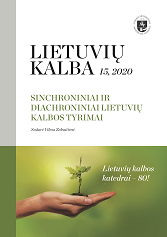TARMIŠKUMAS KAIP IŠMATUOJAMAS DYDIS
DIALECTICISM AS A MEASURABLE VALUE
Author(s): Danguole MikulėnienėSubject(s): Geography, Regional studies, Phonetics / Phonology, Sociolinguistics, Baltic Languages
Published by: Vilniaus Universiteto Leidykla
Keywords: Lithuanian language; dialect; dialecticism; geolects; regiolects;
Summary/Abstract: Traditional dialectology describes dialecticism as a whole of dialectal attributes, while multimodal dialectology portrays it as a certain expression by which those attributes are realised. As a result, an analysis of the latest dialectal formations – geolects and regiolects – faces a varying degree of dialecticism because the most prominent dialectal attributes are ‘erased’ from usage or have become unstable dialectal markers that not everyone and not every time uses. The degree of dialecticism can be measured. One option to reveal it is to apply Fumio Inoue’s method of quantitative values, which the author of this article construes as a relationship between theoretically probable and actually used dialectal forms. The higher the percentage of dialectal instances, the more dialectal the local language variation is. To obtain the most objective view possible, the dialecticism of the language of local informants must not be measured purely as the means of the observable dialectal instances. The boundaries between the minimum and maximum degree of dialecticism have to be mapped at all times. Furthermore, these boundaries need to be verified with statistical methods.
Journal: Lietuvių kalba
- Issue Year: 2020
- Issue No: 15
- Page Range: 1-11
- Page Count: 11
- Language: Lithuanian

